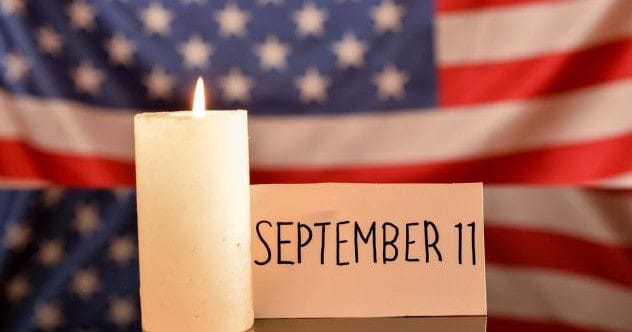By now, the story of 9/11 has been told and retold, the stunning statistics set in stone. Nearly 3,000 dead. Four hijacked planes. Two collapsed skyscrapers. A section of the Pentagon—the defense hub of the world’s most powerful country—seriously damaged. A Pennsylvania field forever impacted.
The images from that day are equally unforgettable. Explosions and implosions, running and screaming, terror and tears. But the sun set and rose again, bringing a new day of urgency, chaos, and, perhaps most hauntingly, eerie silence. Here are ten scenes from September 12, 2001.
The Pile: Ground Zero’s Hellscape
The implosion of the Twin Towers created an unfathomable 1.8 million tons of wreckage over nearly 15 acres. By the time major cleanup was completed in May 2002, more than 108,000 truckloads of debris had been removed from the site.
On September 12, the scene was impossible. A twisted, still-smoldering mountain of metal, several stories high with voids dropping into unknowable depths, stretched out before rescue workers. A thick layer of dust permeated every crack and crevice, making the already indistinguishable even less identifiable.
The media called the site “Ground Zero.” Rescue workers opted for a simpler term: The Pile. On September 12, The Pile presented an unprecedented conundrum. Less than 24 hours after the collapse, there were assumedly survivors pinned in the unstable deathtrap sprawled out before them. How could they be saved without adding more first responders to the death toll?
Civilians had a different name for the WTC wreckage. Those living in high-rise apartment buildings had an indescribably horrible bird’s-eye view of the devastation, reducing the scene to ironic, halting brevity: The Pit.
“The Cones Are Bodies”
Given the sheer magnitude of the tragedy, the dead took a sickeningly broad array of shapes and sizes. Even before the towers collapsed, bodies were strewn across the plaza. Perhaps the unluckiest body was Danny Suhr, the first firefighter killed that day when a falling body landed on him.
As the frantic rescue efforts stretched into September 12, those combing the rubble resorted to marking bodies with orange cones, the type used to block off traffic during construction.
Body parts were simply everywhere, even atop adjacent skyscrapers and stuck in scaffolding in nearby buildings. Part of one body was found nearly a quarter-mile away from the disaster’s epicenter. All totaled, nearly 22,000 body parts would eventually be found—more than seven times the number of deaths.
Understandably preoccupied with finding the living, rescue workers used makeshift markers to tell their comrades that this gruesome ground had already been covered.
The Wall of the Missing
Near the World Trade Center wreckage, families taped missing persons flyers on a nearby building. Hundreds followed suit, creating a gathering point for desperate family members and reporters.
Soon, well-wishers also descended upon the wall, leaving flower wreaths and candles and handing out water and food to inconsolable family members. Though flyers were posted throughout New York City, this became a humanitarian headquarters as emergency workers scavenged for any signs of life.
Those posting flyers often clung to the hope that their loved ones were still alive in the rubble, incapacitated without ID at a nearby hospital, or wandering the streets in a shell-shocked daze.
In the end, very few of the faces on those flyers would ever be seen alive again. Today, a wall of photos depicting all WTC victims can be found at the September 11 Memorial & Museum.
Abandoned Automobiles

At the parking lots of commuter rail stations across Long Island and northern New Jersey, cars slowly disappeared as their owners returned for them, generally after massive delays getting out of Manhattan. Unfortunately, not all the cars left; many belonged to people who died in the Twin Towers.
The New York City metro area is immense, and commuters come from an hour or more away in all directions to reach Lower Manhattan offices. In the aftermath, relatives of victims fetched vehicles from local transportation hubs—a macabre logistical detail of sudden death.
One such place was a vast bus park and ride lot in East Rutherford, NJ, adjacent to Giants Stadium. John Mara, the Giants’ CEO, remembers trying to wish away the eerily unattended cars in the days following the attacks.
“To drive past that every day, to see those cars and know those people had perished, that was just a gut-wrenching scene,” Mara recalls.
Verboten Photo: The Falling Man
On September 12, the Allentown, Pennsylvania, Morning Call ran a long, narrow photo buried on page 28. Only a handful of other papers ran the shot, which was snapped by Pulitzer Prize-winning photographer Richard Drew.
The photo depicts an adult male amid the steel-slatted backdrop of the North Tower, completely vertical as he descends. The scene evokes an uncomfortable faux peacefulness; in reality, the man was plummeting in a violent, flailing spin.
“I have eight or nine frames of this gentleman falling, and the camera just happened to cycle in that time when he was completely vertical,” Drew said later.
It was arguably 9/11’s most disturbing single image, showcasing a hopeless, horrifying choice between burning alive or diving to certain death. Nearly 200 others made the same choice that day. The photo, now known as “The Falling Man,” generated such an uproar that it largely disappeared for several years.
In 2006, a documentary called “9/11: The Falling Man” detailed the controversy surrounding the picture and uncovered the man’s likely identity: Jonathan Briley, a 43-year-old audio technician for Windows on the World restaurant.
Lights Out in the City That Never Sleeps
The 9/11 attacks caused the greatest disruption to America’s cultural, media, and economic capital in the city’s history, only comparable to the COVID-19 pandemic.
The New York Stock Exchange went four full business days without opening. The attack occurred early enough on September 11 that the exchange did not open that day and remained shut until the following Monday. Not since World War I had the NYSE closed for so long.
In Times Square, the bright lights of Broadway failed to shine for scheduled performances for the first time since World War II. The theatres had no shows on 9/11 and stayed dark the next day before beginning to reopen on September 13.
The National Football League canceled all games the weekend following 9/11, moving them to the end of the season. Major League Baseball games were also postponed one week, leading to the World Series being played in November for the first time.
Rerouting NYC’s Heartbeat: The Subway System
The collapse of the towers damaged several vital tunnels in the country’s largest subway system. One station directly under the WTC, Cortlandt Street, was completely destroyed and would draw gasps from riders when the tunnel reopened a week later.
Nearby, a New Jersey commuter rail station known as the PATH was entirely destroyed in the collapse, necessitating a yearslong reroute. Notably, many PATH train occupants were among the first to exit the North Tower following its impact.
Despite the devastation, just a day after the attacks, most of the city’s subways were operating, albeit skipping the majority of stations in Lower Manhattan. One exception was the Lexington Avenue line, which would be inundated to what many called “crush capacity” until its sister routes came back online.
Still, New Yorkers saw riding the subway as an act of defiance against terror. As for the Cortlandt Street station, it didn’t reopen until 2018.
History-Making Headlines: September 12 Newspapers
For the third time in its history, on September 12, 2001, the front page of the New York Times featured a massive 96-point, all-caps font. “U.S. ATTACKED,” it read. The previous two 96 font headlines were July 21, 1969 (“MEN WALK ON MOON”) and August 9, 1974 (NIXON RESIGNS); it would be revived once more on November 5, 2008, upon the election of America’s first Black president (“OBAMA”).
Elsewhere, newspapers scrambled to convey the tragedy with due urgency while remaining within the bounds of decency. The Washington Post prioritized the moment when the world realized this was no mere accident: the second plane approaching the South Tower. The NY Daily News carried a similar image, declaring, “It’s War.”
Across the country and around the world, various combinations of the South Tower fireball and the word “war” were the most common headlines.
Grounded: Stranded at Airports across the Continent
As hijackings mounted on 9/11, the U.S. Federal Aviation Administration ordered the immediate grounding of more than 4,500 aircraft in the country’s airspace. Tens of thousands of travelers ended up at airports other than those on their tickets. There would be no more commercial flights for two full days.
Airports became an odd blend of the completely stunned and the temporarily irate. Would-be travelers stood in terminals, necks craned toward TVs, knowing full well they weren’t going anywhere. Meanwhile, flights arrived with outraged, out-of-the-loop passengers who undoubtedly felt shallow upon learning of the deadly circumstances surrounding their inconvenience.
Many spent three or more days in airport terminals, which today is basically a standard security line.
The emergency made one obscure place famous. In northeastern Newfoundland, Canada, the tiny town of Gander, population 11,800, became a bullseye for nearly 40 planes traveling from Europe to North America. Nearly 7,000 passengers and crew descended on Gander, whose extraordinary hospitality became the premise for the Broadway musical Come from Away.
Fido Finds One
By now, most know the story of John McLoughlin and Will Jimeno, two Port Authority Police Officers pulled from the wreckage of the Twin Towers. The pair was discovered on the evening of September 11—two of only 18 people saved overall.
Very few were rescued once the calendar turned to September 12. The last one was Genelle Guzman-McMillan, who was on the 15th floor of the North Tower when it imploded.
It took 27 hours for Guzman-McMillan to be found by a rescue worker, specifically, a rescue worker with four legs. A German Shepherd named Trakr, one of about 300 employed to find survivors, initiated what would sadly become the disaster’s final rescue.
Guzman-McMillan is still alive today. She regularly shares her story and authored a book about her ordeal, Angel in the Rubble, in 2014.
Reflecting on September 12, 2001, we remember the haunting scenes of a nation in shock, the resilience of its people, and the enduring spirit that emerged from the ashes. The urgency, chaos, and eerie silence of that day serve as a poignant reminder of the human cost of tragedy.
What are your reflections on this day in history? Share your thoughts in the comments below.










